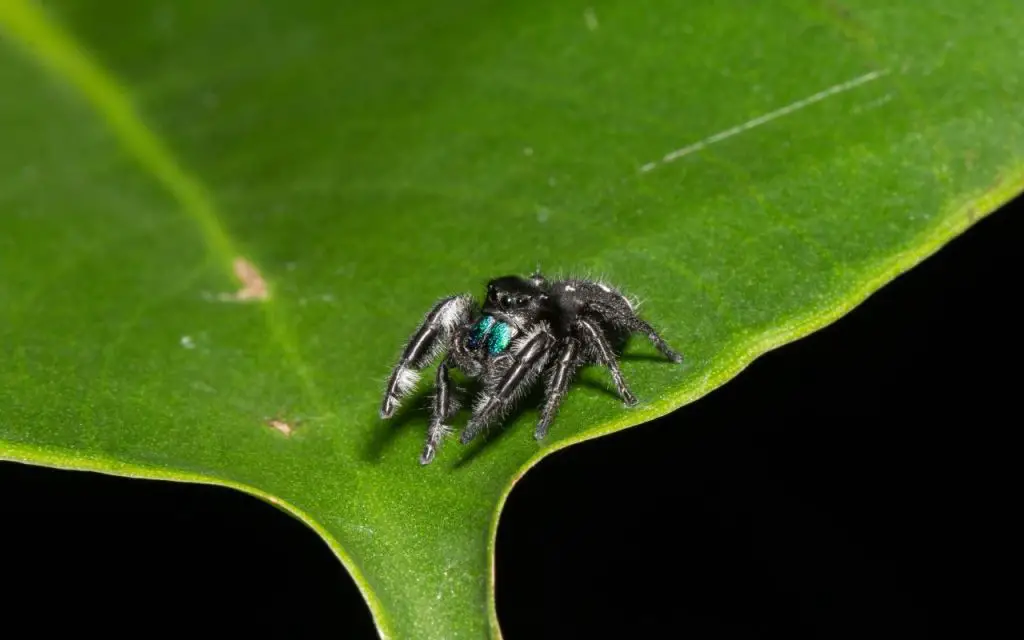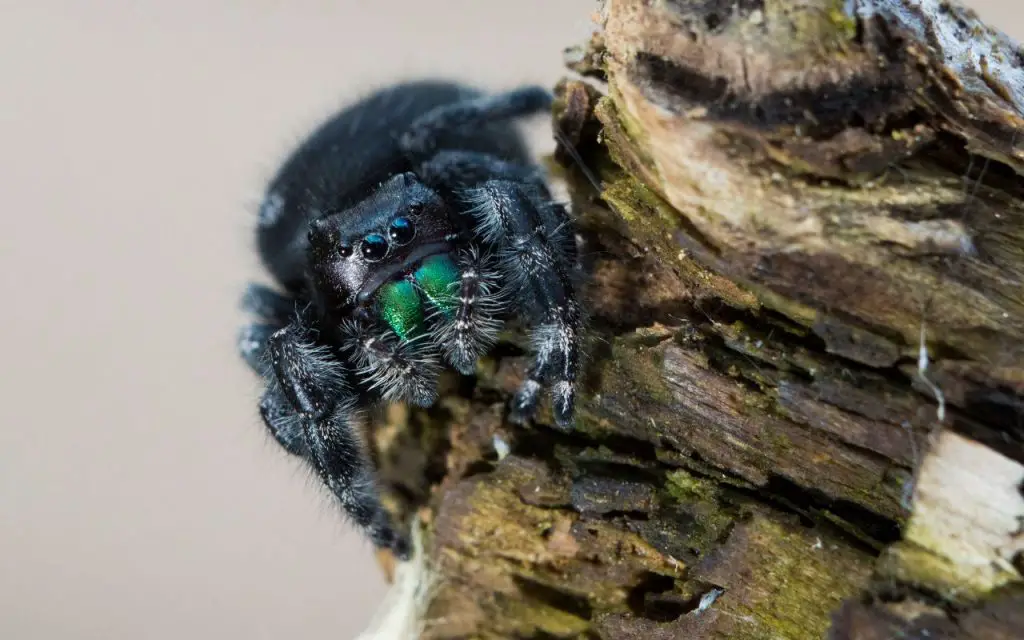Last updated on February 1st, 2023 at 10:03 am
Where do Bold Jumping Spiders live? This species is widespread in the US, and if you live there it could be right outside your door…
Where do bold jumping spiders live? and are they poisonous (venomous is the correct term)? You can find out more about this type of spider by reading this article. This article will provide you with information on the size, sex, and distribution of male and female Bold Jumping Spiders. It will also help you determine what to look for when finding them in the wild. So, get ready to go on a bold jumping spider hunt!
Where can I find a Bold Jumping Spider?
Where can I find a bold jumping spider, and what are its habits? These colorful creatures live alone and also prefer to hunt alone. Typically, they live between one and two years.
More often than not, you encounter them on sunny walls, cars, or tree stumps during the summer when they’re fully grown. In the wild, they range all the way from southern Canada to northern Mexico. They are also found in Puerto Rico, Cuba and finally Hawaii – where they have been accidentally introduced.
Male bold jumping spiders exhibit courtship behavior by raising their legs and displaying colored dots. They also often flee if a female approaches too quickly – rather than get turned into a snack.
This explains why the bold jumping spider has a high probability of surviving in human homes. They make nice, safe places for them to hunt! Sometimes, they also enjoy hunting near screen porches, which is a convenient place for them to try to come inside.
The bold jumping spider can be found in a wide variety of habitats, including outside buildings. Although this species rarely bites humans, it can invade your home, including your car. Despite their appearance, the venom from bold jumping spiders only irritates the skin and cannot be harmful.
Typical habitat types for Bold Jumpers include:
- tree stumps
- porches
- rock outcroppings
- outbuildings
- south-facing walls
- large, flat leaves

Is a Bold Jumping Spider poisonous?
The bold jumping spider is one of the most common species of jumping spiders in North America. This small, furry spider has big watery eyes, eight small legs, and a playful personality.
These spiders are not aggressive and generally shy away from direct contact, although they may land on clothing or the body of a human. This is because the jumping spider doesn’t view humans as prey, but rather as a useful home owner.
The bold jumping spider is one of the largest of the Salticidae and can jump up to 50 times its own body length. It is often seen in gardens, and is conspicuous with its dark body.
Many gardeners are arachnophobic, but they still don’t mind this species in their yard. This is because they are great for pest control. If you watch them, you’ll notice that all they do during the day is hunt for bugs, cutting down the numbers of harmful insects.
The bold jumping spider is not poisonous and is unlikely to bite humans. Their venom is mildly irritating- nothing more. Their behavior depends on where they’re living, and their habitat, but aggression does not seem to be in their nature.

Size
When fully grown, this species averages around 12mm in body size, with females often being slightly larger. That said, some males do have longer legs than females, it’s actually quite variable. This doesn’t sound big, but for a jumping spider it is huge! Many of them are only 3-4mm in length.
The Bold Jumping Spider is a common house guest that is more beneificial than anything else. It is an extremely mildly venomous spider that only bites when threatened and is harmless unless provoked. Despite its size, the Bold Jumping Spider is capable of large leaps and may not be a good choice for people with arachnophobia.
Male vs female Bold Jumping Spider
The male and female of the bold jumping spider are sexually dimorphic, meaning that they differ in appearance. Males are black and have white spots and bands on their legs and abdomen.
Females are often a little larger than males and have orange or reddish markings. Notwithstanding, they also have metallic green mouthparts and chelicerae – just like the males.
Despite the difference between the sex of the male and female bold jumping spider, both are valuable house guests and great pets, living a similar amount of time. If you’re an arachnid enthusiast, both sexes are fascinating to watch.
The male Bold jumping spider performs elaborate courtship displays, moving their front legs, chelicerae and pedipalps. While the female Bold jumping spider guards its eggs until they hatch. Both sexes molt when they reach maturity.

Do Bold Jumping Spiders bite?
Despite the name, bold jumping spiders rarely bite humans. They are primarily predatory but their venom is non-lethal to anything bigger than a bug. It only slightly irritates skin if it bites you.
If you are bitten by a bold jumping spider, it will likely flee away in no time. It is considered safe to keep as an indoor spider, but you should always keep an eye on it when around people.
The scientific name for this species is Phidippus audax. Audax means bold, so it’s no wonder the spider is also called a bold jumper. They’re capable of jumping 50 times their body length!
They’re found in a variety of habitats, including the mountainside slopes of Mount Everest. They have great sighting skills and can hunt for prey in any climate.
The bold jumping spider has black or gray hairy abdomen and legs. The spider’s stereoscopic vision helps it stalk its prey. Its coloration is striking, as well. Its abdomen is black with a white triangular patch.

Bold Jumping Spiders as pets
Despite their venom, jumping spiders are friendly and make wonderful pets. While they are venomous and can incapacitate their prey, humans aren’t overly affected by their bite. In fact, the bite from a jumping spider will only cause mild irritation and redness.
When compared to Tarantulas, Jumping Spiders are even easier to care for, but unfortunately don’t live nearly as long. However, if properly cared for, females can live for two or three years.
During this time, they are fascinating and entertaining captives that thrive on a simple diet and care regimen. Why not check out one of our care sheets to learn more?
Are Bold Jumping Spiders rare?
These small spiders are known scientifically as Phidippus audax and are often called bold jumping spiders. They are named so because of their fearlessness and boldness in taking on large prey. In fact, these animals have the ability to jump many times their body length and accurately land on top of prey!
Besides their unusual personality, bold jumping spiders can be found in many habitats, including the deserts, mountains, and forests. Though they certainly seem to enjoy old builidings most of all. Given how adaptable and fearless they are, it should come as no surprise that they are common throughout their whole distribution.
These arachnids are active, daytime hunters. They use their sharp vision to locate their prey, dive upon it, and dig in. You can also observe them consuming different kinds of prey. The males prefer smaller prey and tend to spend less time hunting than their female counterparts. The females spend more time hunting, however, and they eat more often than males.

Why do jumping spiders look at you?
If you’ve ever wondered why jumping spiders look at you, it’s because they are curious. In addition to their large front eyes, jumping spiders have three pairs of smaller eyes. These eyes, located at the back of their head, help the spider detect objects that may be approaching from behind.
Interestingly, scientists also believe that Bold Jumping spiders can hear sounds from up to 10 feet away.
In reality, however, these arachnids are not particularly aggressive. Their behavior is actually quite friendly, which makes them seem like they’re looking for food. They have big eyes and pedipalps and really look like they’re wondering what you’re thinking.
All in all, jumping spiders are harmless unless they feel threatened.







